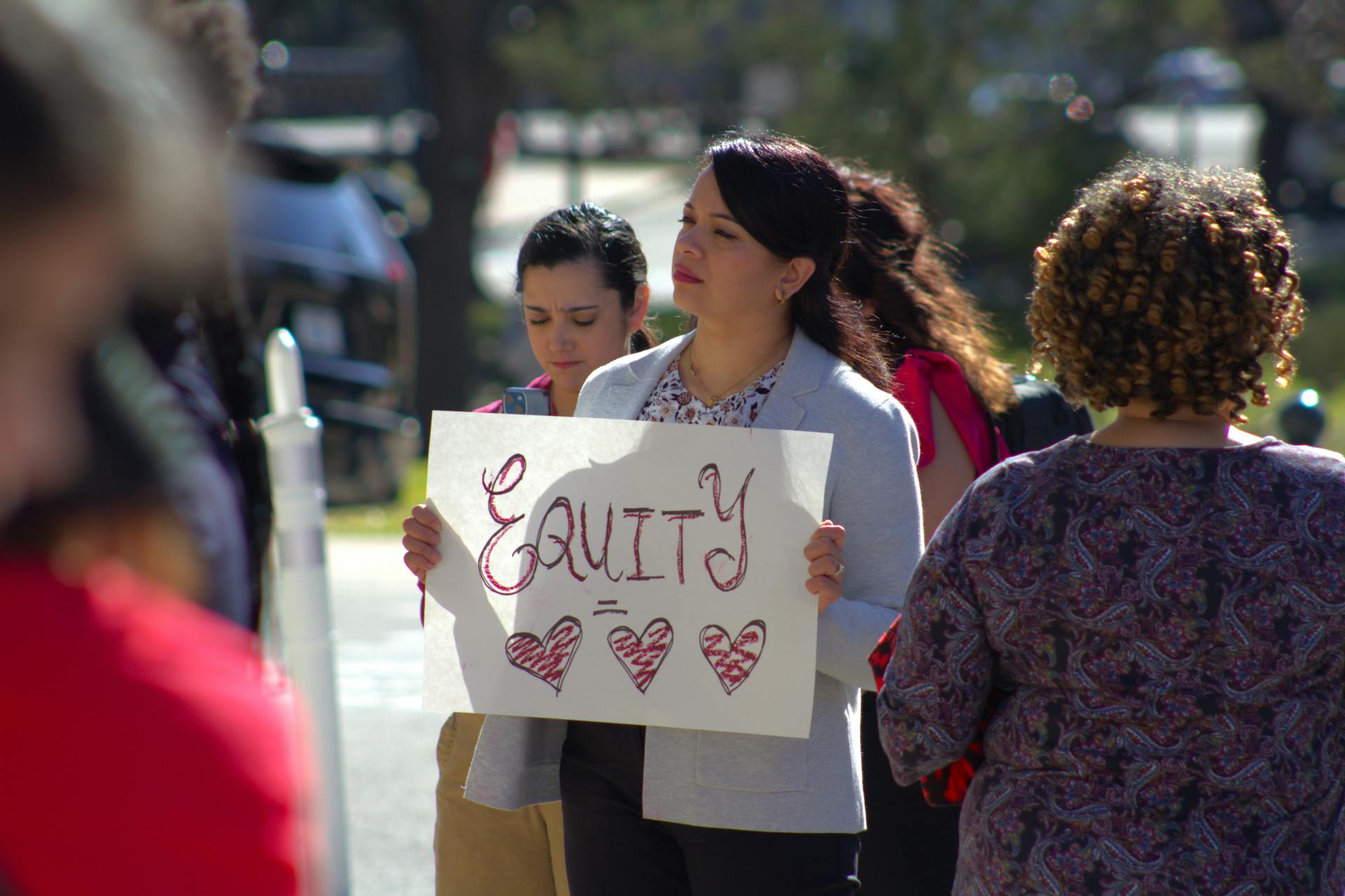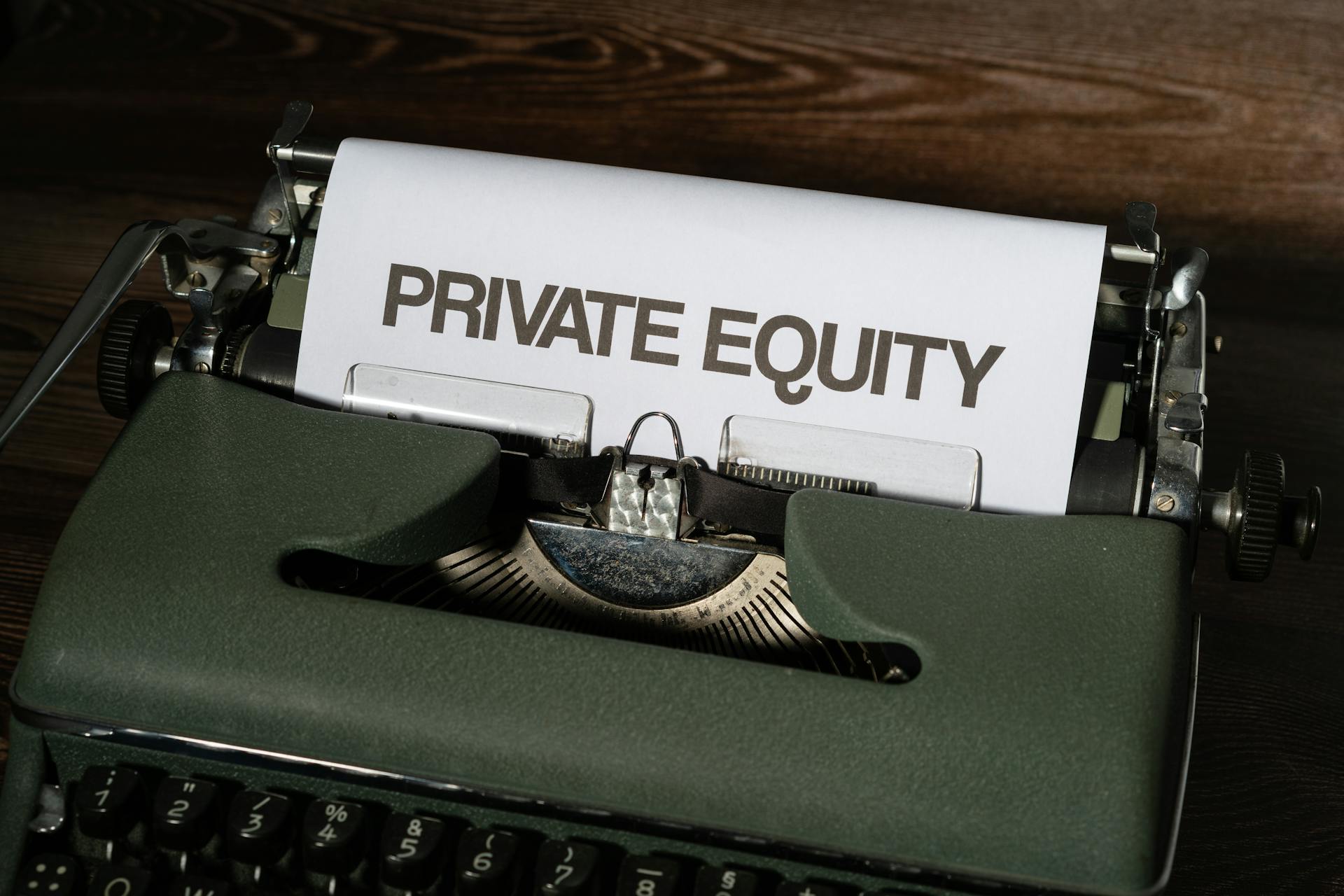
Understanding the concept of required return on equity is crucial for making informed investment decisions.
A required return on equity is the minimum rate of return that investors expect to earn from their investment.
Investors use this metric to determine whether a company's stock is a good investment opportunity.
The required return on equity is influenced by factors such as the company's credit rating and the overall market conditions.
A company with a high credit rating typically has a lower required return on equity, as investors perceive it as a lower-risk investment.
In contrast, a company with a low credit rating may have a higher required return on equity due to the increased risk associated with it.
See what others are reading: Investment Returns Definition
What Is Required Return on Equity
Required Return on Equity is essentially the minimum return an investor expects to earn from a company's equity, given its risk. It's a benchmark that investors use to determine whether a company's stock is a good investment opportunity.
If this caught your attention, see: A Company Has a Minimum Required Rate of Return of
The Required Return on Equity is specific to each investor based on their objectives and investment timeframe, and it can change over time as their circumstances change. Investors consider several factors such as their risk tolerance, investment goals, inflation, and current interest rates to determine their RRR.
To calculate the RRR, investors take into account factors such as the risk-free rate, beta, and market risk premium. The formula to calculate RRR is a crucial component in determining the present value of a project or investment.
A higher RRR indicates that a company's stock is riskier, and therefore, investors demand a higher return to compensate for the higher risk. This is why it's essential to choose investments with expected returns that are higher than the RRR to compensate for the inherent risks.
Here are five key facts about Required Return on Equity:
- Required Return on Equity is the minimum return an investor expects to earn from a company's equity, given its risk.
- The RRR is specific to each investor and can change over time as their circumstances change.
- To calculate the RRR, investors take into account factors such as the risk-free rate, beta, and market risk premium.
- A higher RRR indicates that a company's stock is riskier.
- There is no one RRR that applies to all investments, as it varies depending on the company's risk and the investor's preferences.
Calculating Required Return on Equity
Calculating Required Return on Equity is a crucial step in evaluating the potential return on investment for equity holders. There are several methods to calculate RRR, but two of the most common methods are the Weighted Average Cost of Capital (WACC) and the Capital Asset Pricing Model (CAPM).
The CAPM model is particularly useful for stocks that do not pay dividends, and it uses the beta of an asset to measure its riskiness. The formula for RRR using the CAPM model is RRR = Risk-free rate of return + Beta X (Market rate of return - Risk-free rate of return).
To calculate RRR using the CAPM, you need to subtract the risk-free rate of return from the market rate of return, multiply the result by the beta of the security, and then add this result to the risk-free rate to determine the required rate of return.
Dividend Discount Model
The Dividend Discount Model is a popular method for calculating the Required Return on Equity (RRR) of a dividend-paying stock. It's a straightforward approach that considers the current stock price, dividend payment per share, and forecasted dividend growth rate.
To use the Dividend Discount Model, you'll need to know the expected dividend payment and the share price. For example, let's say a company's stock is trading at $100 a share and it's expected to pay an annual dividend of $3 next year.
You might like: Payout Ratio vs Dividend Yield
The formula for the Dividend Discount Model is RRR = (Expected dividend payment / Share Price) + Forecasted dividend growth rate. This means you'll take the expected dividend payment and divide it by the current stock price, then add the forecasted dividend growth rate to the result.
For instance, if the forecasted dividend growth rate is 4%, the RRR would be 7% or (($3 expected dividend / $100 per share) + 4% growth rate).
Here's an interesting read: What Is Average Dividend Yield
Formula Calculator
Calculating Required Return on Equity can be a complex task, but with the right tools and formulas, it's definitely doable.
There are various ways to calculate the required rate of return, and two of the most common methods are the Weighted Average Cost of Capital (WACC) and the Capital Asset Pricing Model (CAPM).
The Required Rate of Return Calculator is a handy tool that can help you calculate the required rate of return using the CAPM formula.
You might like: Required Rate of Return Capm
The CAPM formula is: Risk Free Rate + Beta x (Whole Market Return - Risk Free Rate).
You can use the following inputs in the calculator: Risk Free Rate, Beta, and Whole Market Return.
Here's a simple example of how to use the CAPM formula: if the Risk Free Rate is 0, Beta is 0, and the Whole Market Return is 0, the required rate of return would be 0.
Alternatively, you can use the WACC formula to calculate the required rate of return. The WACC formula is: WACC = E/VCe + D/VCd(1-T).
This formula takes into account the value of Equity (E), the value of Debt (D), the Cost of Equity (Ce), the Cost of Debt (Cd), and the effective tax rate (T).
Understanding the Required Return on Equity
The required return on equity is a crucial concept in investment analysis, and it's essential to understand how it works. It represents the minimum return an investor expects to receive in order to justify the level of risk undertaken.
The required return on equity serves as a benchmark for evaluating investment opportunities, taking into account factors such as the risk-free rate, market risk premium, and specific risk associated with the investment. By comparing the expected return of an investment to the required rate of return, investors can make informed decisions regarding the attractiveness of the investment.
To estimate the required return on equity, investors can use various models, including the Capital Asset Pricing Model (CAPM) and the Dividend Discount Model (DDM). The CAPM is a widely used model that incorporates the risk-free rate, market risk premium, and beta coefficient to calculate the expected return for an investment.
The required return on equity is not the same as the cost of capital, which is the minimum return needed to cover the cost of debt and equity issuance to raise funds for a project. The required return on equity should always be higher than the cost of capital.
Here are the key components of the required return on equity:
- Risk-free rate: The return an investor can expect from a risk-free investment, such as government bonds.
- Market risk premium: The additional return investors demand for bearing the systematic risk associated with investing in the overall market.
- Beta coefficient: The sensitivity of an investment's returns to changes in the overall market.
By understanding these components and using the right models, investors can accurately calculate the required return on equity and make informed decisions about their investments.
Factors Affecting Required Return on Equity
The Required Rate of Return (RRR) is a crucial concept in finance, and understanding what affects it can help you make informed investment decisions.
The RRR is influenced by several key factors, including the risk-free rate. This is the rate of return an investor can expect from a low-risk investment, such as a government bond.
The market risk premium is another significant factor that affects the RRR. This is the extra return an investor demands for taking on additional risk.
Beta is also a vital component in determining the RRR. It measures the volatility of an investment relative to the overall market.
Here are the key factors affecting the RRR in a concise summary:
A higher RRR indicates that an investment is riskier, and investors demand a higher return to compensate for the higher risk. This is a fundamental principle of finance that can help you evaluate investment opportunities.
Additional reading: Private Equity Investment Returns
Calculating Required Return on Equity Examples
Calculating the required return on equity (RRR) is a crucial step in evaluating investment opportunities. You can calculate RRR using the dividend discount model (DDM), which takes into account the expected dividend payment and growth rate.
For example, if a company is expected to pay an annual dividend of $3 next year and its stock is trading at $100 a share, with a 4% growth rate, the RRR would be 7% or (($3 expected dividend / $100 per share) + 4% growth rate).
The capital asset pricing model (CAPM) is another way to calculate RRR, using the beta of a security and the excess return over the risk-free rate. A company with a beta of 1.50, for instance, would have an RRR of 14% or (2% + 1.50 X (10% - 2%)).
Here are some examples of calculating RRR:
As you can see, the RRR varies depending on the beta of the security. A higher beta indicates a higher RRR, reflecting the increased risk of the investment.
In the case of XY Limited, a food processing company with a beta of 1.30, the RRR would be 7.6% or (5% + 1.3 * (7% - 5%)). This means that an investor would require a 7.6% return on their investment to match the market's expected return.
It's worth noting that the RRR can also be calculated using the dividend growth rate and expected dividend payment. For example, if XY Limited pays a dividend of Rs.140 per stock and has a dividend growth rate of 7%, the RRR would be 77% or (140 / 200) + 7%.
These examples illustrate the different methods for calculating RRR and highlight the importance of considering the beta and dividend growth rate when evaluating investment opportunities.
Suggestion: Forward Dividend & Yield Meaning
Tools and Resources for Calculating Required Return on Equity
Calculating required return on equity can be a complex task, but there are tools and resources available to make it easier.
The Required Rate of Return Calculator is a useful tool for calculating required return on equity. It takes into account the risk-free rate, beta, and whole market return to calculate the required rate of return.
You can use the following formula to calculate required return on equity: Risk Free Rate + Beta x (Whole Market Return - Risk Free Rate). For example, if the risk-free rate is 0, beta is 0, and the whole market return is 0, the required rate of return would be 0.
There are two common methods for calculating required return on equity: Weighted Average Cost of Capital (WACC) and the Capital Asset Pricing Model (CAPM).
See what others are reading: Free Cashflow Yield
Frequently Asked Questions
Is WACC the same as RRR?
WACC and RRR are related but not identical concepts, with WACC being the cost of capital for a company, while RRR is the minimum return investors expect. Understanding the difference between these two metrics is crucial for informed investment and financial decisions.
Sources
- https://www.investopedia.com/terms/r/requiredrateofreturn.asp
- https://www.datarails.com/finance-glossary/required-rate-of-return/
- https://www.educba.com/required-rate-of-return-formula/
- https://www.acquire.fi/glossary/required-rate-of-return-rrr-definition-and-examples
- https://fastercapital.com/topics/understanding-the-required-rate-of-return.html
Featured Images: pexels.com


